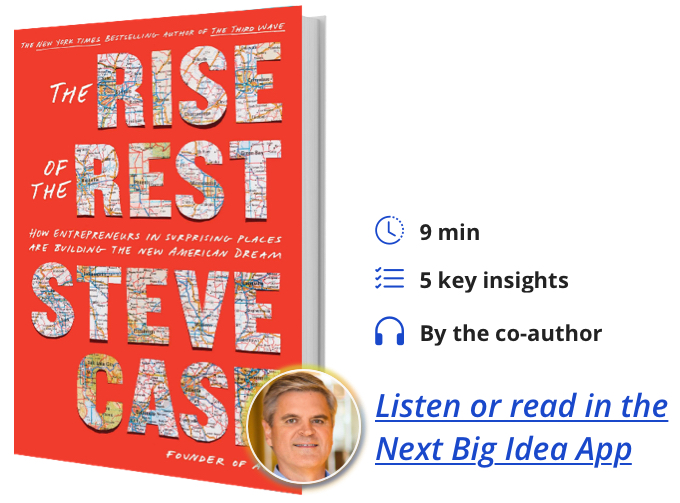Steve Case is an entrepreneur, founder of AOL, and Chairman and CEO of Revolution, a Washington D.C.-based investment firm. Case also was the founding co-chair of the National Advisory Council on Innovation & Entrepreneurship, and a member of President Obama’s Council on Jobs and Competitiveness, where he chaired the subcommittee on entrepreneurship.
Below, Steve shares 5 key insights from his new book, Rise of the Rest: How Entrepreneurs in Surprising Places are Building the New American Dream. Listen to the audio version—read by Steve himself—in the Next Big Idea App.
1. Talent is equally distributed, but opportunity is not.
Seventy-five percent of venture capital goes to just three states: New York, California, and Massachusetts. That leaves the other 47 states to compete for just 25 percent. It wasn’t always this way; in the 1980s we had a well-distributed innovation economy where IBM, Dell, Gateway, Sprint, and AOL were all in cities across the country. Over time, tech started to concentrate in Silicon Valley and a cycle emerged where the Bay Area’s network density led to a brain drain in the middle of the country, as many people felt compelled to move to the coasts.
Rise of the Rest is about taking action to stop the cycle of dollars flowing to the same type of people for the same types of ideas in the same types of places. Revolution has invested in more than 200 companies across 100 cities in an effort to put my money where my mouth is. At the end of the day, Rise of the Rest is an optimistic vision of the future whereby the coastal tech hubs will not fall but dozens of other cities will rise.
2. Startups are responsible for all net new job creation—supporting them is critical for our economic future and to knit together the growing divides in our country.
People in the middle of the country feel left out and left behind. That’s not surprising when the innovation economy has not offered any opportunities for them or their children. By focusing on creating startups, we can start to change that. Cities need to focus on what’s next. They need to seed new companies, rather than spending all their time trying to lure existing companies to move.
“Over time, tech started to concentrate in Silicon Valley and a cycle emerged where the Bay Area’s network density led to a brain drain in the middle of the country.”
In order to do so, we also need to create national, state, and local policies to support startup ecosystems—everything from policies like the CHIPS Act, which authorized money for regional tech hubs and more research and development spending; to state tax credits for investing, and university programs focused on entrepreneurship; to public-private partnerships to establish places for entrepreneurs to gather and exchange ideas.
3. The pandemic accelerated certain technologies and the distribution of talent and capital.
The genie is out of the bottle. A lot of people have decided to rethink where they live and how they work, and that’s fueling a boomerang of people returning to their home cities. Investors are now used to meeting entrepreneurs via Zoom and are therefore more open to investing in startups in other parts of the country.
Last year my investment firm Revolution did a report with PitchBook that found that 1,400 new venture firms have launched over the last decade in cities outside of the Bay Area. As a result, more entrepreneurs now have access to the money they need to start and grow their startups.
4. Placemaking is here to stay.
Cities will continue to find new ways to differentiate themselves to attract talent, focusing more on cultural amenities such as music and food, building new parks to promote outdoor advantages, launching new forms of transportation, or offering financial incentives, including payments to move or rental credits. Cities that used to compete for companies are now competing as magnets for people.
“Cities will continue to find new ways to differentiate themselves to attract talent.”
State and city policies will start to try and attract or disincentivize people from moving to a specific place. They may make changes to their taxes, economic benefits for first-time home buyers, or social policies around hot-button issues.
5. The entrepreneurial future must be inclusive.
Today, female founders get less than 10 percent of all venture investment dollars, Latino founders get less than two percent, and Black founders less than one percent. This has to change if we are going to remain the most innovative nation. We need to create a more inclusive innovation economy. This is not only right, it is also smart—study after study confirms that diverse leadership teams produce better financial results.
To listen to the audio version read by author Steve Case, download the Next Big Idea App today:
































